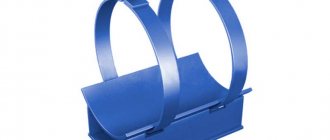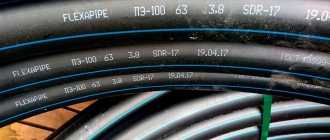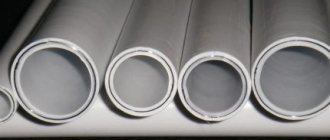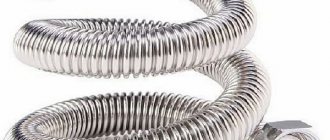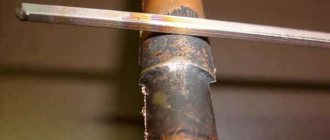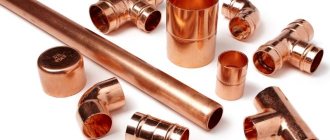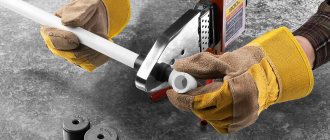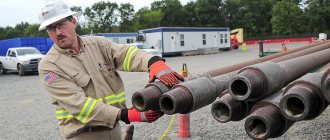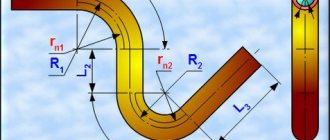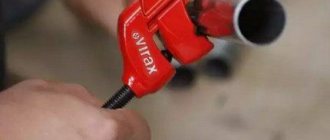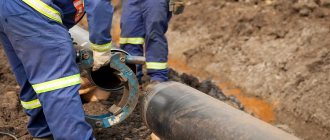No previously used thermal insulation method can achieve the same result of insulation and reduction of heat losses as pipes in PPU insulation can achieve. The features of this method, as well as the principles of its use, will be described in this article.
The use of factory-insulated pipes reduces the installation time of utility networks and reduces maintenance costs
Materials for joining products
PPU pipe connection diagram.
High-quality sealing of product joints is the most important condition for trouble-free and reliable operation of heating network pipelines.
The use of a heat-shrink sleeve or tape to insulate the joints of PPU pipes makes it possible to protect the thermal insulation of polymer materials by creating a protective polymer or steel casing, which in its qualities and thermal insulation characteristics will be similar to the shell of the product.
Depending on the method of pipeline installation, an adhesive-based heat-shrink sleeve (with an applicator) or a galvanized steel casing with heat-shrinkable tape complete with polymer locks can be used to insulate the joints.
To isolate joints, the following connection kits are available:
1. For products with a galvanized shell:
Sequence of installation of polyurethane foam pipe.
With polyurethane foam components:
- galvanized casing;
- polyurethane foam components;
- seal.
With polyurethane foam shell:
- galvanized casing;
- polyurethane foam shells.
2. For products with a polyethylene sheath:
With galvanized casing and polyurethane foam components:
- galvanized casing;
- heat shrink tape;
- polyurethane foam components;
- seal.
With polyurethane foam shell:
- heat shrink tape;
- polyurethane foam shells.
The use of materials for sealing joints that do not meet the existing requirements of GOST 30732-2006, as well as non-compliance with the entire technology for insulating polyurethane foam joints, will create the preconditions for violation of insulation protection in the most vulnerable places of any pipelines - the junction of the pipe and the shaped element. The result of this will be the occurrence of premature external corrosion of the pipe with subsequent failure of the pipeline or the need for constant expensive repair work.
Laying a pipeline is impossible when using only a straight product, since it often becomes necessary to change its direction or make a branch. For such purposes, manufacturers provide for the production of various shaped products:
- transitions;
- fixed supports;
- tee branches;
- Z-shaped elements;
- various bends, etc.
Straight sections of products, shut-off valves (in most cases ball valves) and shaped products are supplied by manufacturers with thermal insulation already applied during the manufacturing process, having a “pipe-in-pipe” design.
You are unlikely to need these products when repairing the plumbing and heating system of your apartment. But to supply hot water or heating to a country building or connect to a heating main for heating a large warehouse, this product will be simply irreplaceable.
Laying out the system
How are pipes insulated with polyurethane foam installed? The most painful place in this process is sealing the joints, so it is worth talking about it in more detail.
Materials for work
In addition to pipes, the process will require the following elements:
- shut-off valves;
- supports;
- bends;
- Ball Valves;
- Z-shaped elements;
- tees;
- connection kits (tape, heat-shrink sleeve, locking casing, seal, etc.);
- galvanized pipe - in polyurethane foam insulation is used for installation of overhead routes.
Pay special attention to the quality of purchased materials for sealing joints. They must comply with GOST, otherwise there will be a risk of destruction of the system at the junction of the elements. First, rust will appear, and then leaks.
Installation
Remember the stages of installation of the system.
- Step back 30 cm from the edge of each element and strip off the insulation along this section.
- Carry out welding work. Check the strength of the connection using a special device - a flaw detector.
- Make sure the connection points are dry and clean.
- Install a heat shrink sleeve onto the structure.
- Fill the space between the coupling and the base pipe with polyurethane foam.
- While heating, press down the coupling. With this step you will achieve perfect tightness of the outer layer.
This is important to know! When connecting elements coated with polyurethane foam or polyethylene, do not forget about the flammability of these materials - during welding work, cover the ends with non-flammable material, for example, asbestos fabric.
Thanks to the use of pipes with PPU insulation, you can not only keep heat in the system and keep the nerve cells in order, but also save on installation and maintenance of the network.
Sealing joints of pipes covered with polyurethane foam insulation materials and methods
PPU pipes are a highly reliable modern design. Installation of these products should be carried out in accordance with regulatory standards and manufacturer’s recommendations. The technology for laying pipes is quite simple, but it must be carried out in accordance with all quality and safety requirements. In case of violation of the standards, a reduction in service life and other negative consequences is possible. According to the manufacturer’s recommendations, the technology for installing polyurethane foam pipes, and in particular welding work and sealing joints, can only be carried out under temperature conditions above zero and at normal humidity levels. Given the vagaries of the weather, you will need to purchase a special heated installation tent that can protect the work area from any bad weather. The pipe welding process is performed directly at the bottom of the trench. Welding of straight elements is carried out on the edge; upon completion of the work, the pipes are laid in place.
Preparation and installation
Installation of polyurethane foam pipes
Initially, all components must be carefully checked for punctures, cracks, cuts, chips or tears. In short, products should not have mechanical damage. If they are still found in the shell, they should be sealed by applying heat-shrinkable sleeves or extrusion welding.
All components are laid using a crane at the bottom or edge of the trench. If pipes are lowered into a trench, this must be done smoothly and without impact. If the pipeline is laid on a sandy base, it should not contain bricks, stones or other inclusions that could damage the products.
After all, statistics say: about thirty percent of all damage to pipelines occurs during their installation.
Polyurethane foam
This material has many advantages that make it popular. PPU is a shell or insulation that has useful properties: thermal conductivity, as well as the ability not to lose its structure for a long period of time.
This polyurethane foam is created on the basis of two components Izolan-45 and Voratek CD 100.
And the refinement of the technology for processing polymer materials makes it possible to create shells for insulating products of different diameters. Installation of polyurethane foam insulation can be carried out both for a new pipeline and for the repair of an old or certain section of it.
Description of PPU pipes
PPU pipes
Such products are used quite widely for laying heating networks in above-ground and ductless environments.
For above-ground installation, pipes are made with a protective metal sheath. For channelless – with an outer protective shell of low-density polyethylene.
There can be two types of insulation: 1PPU and 2PPU. The latter are used in regions with low temperatures, the first type - in regions with a temperate climate.
About the speed of installation of thermal insulation
Pipelines with insulation
Work on installing polyurethane foam insulation is carried out quite quickly, especially when compared with other methods. Moreover, this method is easy, effective and inexpensive - an ideal option. If there is a need for this, thermal insulation can be formed using separate elements. The material is easy to cut and fit to a specific pipe.
You can also reuse the shell if its quality was not affected during the first use. All this makes PPU material an excellent method for pipe insulation. This can be confirmed by numerous videos demonstrating the process.
Conclusion
Thermal insulation of pipelines by spraying polyurethane foam allows you to protect the metal from corrosion, wear, and also reduce heat loss by more than 30%. produces and sells a whole line of polyurethane foam components for thermal insulation of oil and gas pipelines, heating mains and other industrial buildings. All products have been tested and are ready to be sprayed. "Khimtrust SKN-60 G3" is suitable for seamless insulation of gas pipelines and civil engineering projects. "Khimtrust SKN-40/141 G3" is used to protect pipelines, roofs and foundations from cold.
Delivery of Khimtrust products is possible throughout Russia and the CIS countries. We provide a discount when ordering over 1 ton in the online store.
Laying a pipeline using polyurethane foam pipes
It is worth remembering that the ends of the stripped insulation must be covered with non-flammable material during welding.
Installation of the PPU product consists of the following main stages:
- The thermal insulation is stripped to a distance of no more than 300 mm from each edge of the product;
- a welded joint is made, which must be checked for strength using a portable flaw detector;
- A heat-shrinkable sleeve is mounted on the pipe;
- the cavity under the heat-shrinkable sleeve is filled with polyurethane foam, after which the sleeve is settled in place by heating it, thereby ensuring the tightness of the outer layer of the joints.
When sealing joints, you should know that, due to the fact that polyethylene and polyurethane foam are flammable materials, the ends of the stripped insulation must be covered with any non-flammable material during welding work. To protect the outer shell, you can use, for example, asbestos fabric.
Often, installation of pipes that have pre-installed thermal insulation is carried out using horizontal drilling. In a large populated area, digging up a busy highway is very problematic. However, how to insulate a pipe if it has already been pulled through a horizontal puncture in the ground? And this is where a product with a polyethylene shell, on which thermal insulation is pre-installed, comes to the rescue.
What type of pipe joint insulation is there?
The final stage of pipeline construction, namely the insulation of pipe joints, occurs when insulating material - polyurethane foam - is placed in the entire open area. Polyurethane foam is also used to insulate the remaining length of the structure; insulation is applied at the factory.
There are two technologies for filling the joint:
- Filling joints with liquid polyurethane foam. Installation of polyurethane foam shells or couplings.
Both the first and second methods can be called practical and effective. Among the advantages of shells are the following qualities:
- Many manufacturers produce shells with different thicknesses, which allows you to select the optimal thermal insulation for a specific climate zone. Reinforced insulation will be effective even at temperatures falling beyond -100 degrees; it is the polyurethane foam type of insulation that is used most often, since this polymer is characterized by increased resistance to moisture, pressure and mechanical damage; when using polyurethane foam shells produced in factory conditions, there is no risk uneven filling of liquid polymer. And insulation vulnerabilities lead to premature corrosion of the steel pipe under the polymer layer.
Joints can be insulated by pouring liquid polyurethane
At the same time, the technology of filling with liquid polyurethane foam remains competitive and ensures high adhesion to existing insulation layers.
We supply the following materials and systems - click on the required one
The EnergoIzolyatsiya company supplies rigid polyurethane foam shells designed for thermal insulation of hot water supply and heating pipelines, oil pipelines, etc. with a diameter of 22 to 1020 mm. The PU foam shell is made up of rigid cylinders, half-cylinders or segments 1000 mm long, thick..
The EnergoIzolyatsiya company supplies rigid polyurethane foam shells coated with foil, intended for thermal insulation of hot water supply and heating pipelines, oil pipelines, etc. with a diameter of 22 to 1020 mm. The PU foam shell is made up of rigid cylinders, half-cylinders or long segments..
The EnergoIzolyatsiya company supplies rigid polyurethane foam shells coated with galvanized steel, intended for thermal insulation of hot water supply and heating pipelines, oil pipelines, etc. with a diameter of 22 to 1020 mm located on the street. The PU foam shell is a hard cylinder..
In addition to polyurethane foam shells, our company also supplies polyurethane foam bends for thermal insulation of pipes, as well as polyurethane foam shells themselves, available in the following versions: polyurethane foam bends without external coating (without cladding) polyurethane foam bends foil-coated polyurethane bends covered with fiberglass galvanized leather..
Showing 1 to 4 of 4 (pages: 1)
PPU shell
are
rigid
cylinders, half-cylinders or segments, usually 1000 mm long, 30 mm thick, intended for thermal insulation of pipelines with coolant temperatures up to +120ºС, oil pipelines, gas pipelines, etc. It is possible to manufacture shells with a protective coating of foil, fiberglass, galvanized metal and other covering material.
More expensive options come with longitudinal and transverse locks, while cheaper ones simply have flat edges without locks. Photos of the castles below
You need to take into account the nuances of installation: Tough!
this means that you won’t be able to squeeze the cylinder somewhere at the weld joint. If the weld joint is thick and hits the middle of the shell, the edge of the shell may protrude by 5-10mm. All irregularities that interfere with the installation will need to be cut out of the shell (cleaned) so that they do not interfere with a tight fit.
Before installing the shells on the pipeline, it is necessary to carry out measures to prepare the surface of the pipe; it must be cleaned of dirt, scale and rust, degreased and primed.
Methods for installing shells:
One of the undoubted competitive advantages of polyurethane foam shells is the ease of installation. However, despite the simplicity of the pipeline insulation process, it is recommended to take into account the following recommendations:
1) Installation of polyurethane foam shells can be done at any time of the year, provided there is no precipitation;
The pipe must be dry!
— If moisture gets under the PU foam shell, it will cause multiple corrosions, like in a greenhouse — example in the photo:
2) Before installing the PPU shells, it is necessary to treat the surface of the insulated pipe with an anti-corrosion primer. The soil must dry!
3) When joining the half-cylinders and the shells themselves, it is necessary to coat the joints with one-component polyurethane glue to ensure the best waterproofing. The glue is applied to one of the surfaces, then the adhesive surface is treated with sprayed water. After this, the shells are installed with technological fixation, within one day, using bandages. Glue consumption is no more than 300 g/m². The shell is securely fastened, the connection is seamless, not detachable;
4)Quick installation
by fastening the shells to the pipe with plastic ties, metal tapes, and binding wire. Access to damaged pipes, fistulas and cracks, reusable. The cylinders can be tightened either with ordinary plastic clamps manually or with a special polypropylene tape (12 and 19 mm) using plastic or metal locks. In the latter case, a special device is needed - a tensioner.
5) For foil shells, after installation is completed, it is recommended to glue the joints of the longitudinal and transverse locks with foil tape
Important! Foil shells can be used without an additional covering layer only indoors. According to SP 61.13330.2012, you ALWAYS need to make a protective covering layer on the street - either or
Requirements for sprayed surfaces
Before starting work on spraying thermal insulation from polyurethane foam onto the pipeline, the surface must be prepared. This will affect the quality of the sprayed layer and help increase adhesion to the surface. The surface must meet the requirements of SNiP 3.04 01-87. In winter, polyurethane foam can also be sprayed, but it is necessary to use spray systems marked “Winter”. For example, SKN-30/141-G3 (winter), SKN-40/141-G3 (winter), SKN-60/141-G3 (winter).
Polyurethane foam can be applied to roofing felt, slate, metal without dismantling them, but after preparing the surface for spraying:
- Clean the pipeline from dust, dirt, and oils.
- Remove corroded areas.
- Check the surface for uniformity; there should be no peeling or broken parts.
- Ensure the air and surface temperature in the work area is at least +10 °C when working with summer systems and -10 °C when working with winter spraying systems.
- Check surface moisture. It should be dry.
PPU insulation technology
What is PPU pipe insulation? The name is intricate, but the process is simple - like all ingenious things. The design is essentially an ordinary pipe, but coated with a special layer that reduces wear of parts and reduces heat transfer losses in the network. The coating material is called polyurethane foam, hence the name of the product - polyurethane foam.
Manufacturing of structures
What methods of implementation of polyurethane foam pipe insulation do manufacturers practice? The coating is applied in two ways:
- By making a “shell”.
- By filling. This technology is also called “pipe in pipe”.
In simple terms, PPU thermal insulation for pipes is a kind of “fur coat” put on the base shell. So, what is included in such a design?
- the deepest layer is the steel base;
- middle thermal insulation layer – polyurethane foam;
- protective shell.
Everything is clear with the first two positions, but what is used as protection for products? It all depends on where and under what conditions you lay communications. If the network runs above the ground (aerial laying), then galvanized steel is chosen as protection, when installing the system in the ground involves the use of a polyethylene sheath.
This is important to know! Products covered with polyurethane foam must be protected from getting the ends wet during transportation to the installation site and storage in the open air, otherwise short circuits in the wires may occur during installation. If the insides of the elements are wet, dry everything thoroughly before use.
Advantages of PPU coating
Pipes with polyurethane foam insulation have long been popular, but for us such products are still a novelty. Get acquainted with the advantages of the design and modernize your farm.
So, the advantages of polyurethane foam-coated networks:
- increased service life (with proper installation, the life of the system can be extended several times – up to 30 years);
- reduction of heat loss during heat transfer (approximately up to 40%);
- ease of installation (you do not need complex equipment for insulating polyurethane foam pipes, since such products can be laid directly into a trench using technology - without the use of traditional concrete rings or the construction of a well);
- design features make it possible to quickly determine on which section of the water supply route the accident occurred;
- the absence of toxic materials in the composition of the product, which makes them the favorites of users who adhere to naturalness in everything;
- reducing the cost of road repairs;
- eliminating the risk of system wetting due to moisture condensation;
- high heat resistance of products, thanks to which they can be installed even in areas with harsh climates;
- the possibility of using a remote control system for the humidification of network elements.
Features and advantages of PPU insulation
There are increased demands on materials, design and installation of networks, which is due to the significant operating pressure and temperature of the coolant. And the insulation characteristics determine the level of heat loss on the route. We suggest using PPU - polyurethane foam, which has high insulating properties. Compared to traditional materials used for laying such lines, it provides the following basic advantages:
- reduction of heat loss up to 40%;
- increased service life - for polyurethane foam it is about 30 years instead of the usual 10-15;
- reduction of repair costs (3 times).
What are the advantages and disadvantages of pipes
Despite their good thermal conductivity and durability, PU foam pipes have both advantages and disadvantages. Let's take a closer look at the pros and cons of polyurethane foam pipes.
Advantages:
- PPU insulation has a low thermal conductivity coefficient.
- The operating temperature can range from minus seventy degrees to plus one hundred and thirty degrees Celsius.
- Moderate ability to absorb liquids was noted.
- The density of the material is fixed at the highest level.
- The service life without major repairs ranges from twenty-five to thirty years.
- Heat loss can be as low as one or two percent.
- The monitoring system monitors the likelihood of a leak.
- Saving money.
- The pipe kit includes everything necessary for quick installation - bends, tees, fittings and compensators.
- When compared with other types of thermal insulation materials, PPU pipes will be lighter than similar structures with PPM or APB insulation.
- When using pipes, there is no need to take additional measures to combat corrosion.
What are the disadvantages of PPU pipes:
- Despite the long service life and the presence of operational remote control, polyurethane foam pipes are also susceptible to corrosion. Due to the fact that the metal pipe is in a protective shell, the corrosion process becomes less noticeable;
- The heat resistance of the insulating material does not exceed one hundred and thirty degrees, which does not allow the use of pipes in heating networks operating under different temperature schedules: one hundred and forty by seventy and one hundred and fifty by seventy degrees. Pipes can withstand such temperature fluctuations provided that an additional heat-insulating layer is laid (for example, Vector coating or polymer concrete);
- polyurethane foam is not particularly durable and is not resistant to mechanical stress;
- If moisture gets on the heat-insulating layer, the pipe may quickly become damaged by corrosion. As a result of this factor, the use of an additional hydroshell (a durable polyethylene layer) cannot be excluded;
- If a certain section of the insulation is damaged or moistened, then there is a need to completely replace a section of the heating network. PPU insulation cannot be repaired separately;
- PPU insulation is a flammable material;
- Each pipeline or heating network must be equipped with UEC systems for measuring the humidity of the insulating layer.
Varieties of galvanized pipe insulation
The following technology is used in the production of polyurethane foam pipes:
- The supporting steel pipe is dried and cleaned of dirt, scale and rusty deposits, and ring supports made of plastic are placed on it.
- A copper conductor is threaded through the holes of the supports along the entire length of the workpiece.
- The pipe is pushed onto centralizers into the zinc sheath.
- Plugs are inserted into the ends, the surface is heated and liquid polyurethane foam is poured into the interpipe space.
- After technical quality control and marking, the pipe is sent to a warehouse for storage.
Pipes with PPU thermal insulation are produced with a diameter of 32 to 1420 mm (GOST 30732-2006); their length for a pipe diameter up to 219 mm is in the range of 8 - 12 m, for diameters over 273 mm the length is 10 - 12 m.
To increase the service life of products, galvanized pipe insulation is additionally coated on the outside with paint, polymer and waterproofing compounds (bitumen primer), which are renewable during operation.
Rice. 7 Shaped connectors according to GOST 30732-2006
The length of the pipe coating should be equal to the polyurethane layer with a margin of 50 mm at the edges; the polyurethane ends of the pipes and fittings are covered with bitumen-rubber or other waterproofing. When supplying pipes up to 426 mm in size, they must have two diagonally arranged copper wires with a cross-sectional area of 1.5² mm; if the diameter exceeds 530 mm, three wires are used for 3, 9 and 12 o’clock.
To connect sections of the main line, change its direction and install branches, a wide range of shaped products are used in the form of bends, transitions, tees with direct and parallel taps, S-shaped shaped elements, plugs and end elements. Shaped parts can have built-in shut-off valves and gate valves; their service life is at least 30 years.
Rice. 8 Shaped elements for joining when laying pipelines
PPU shell coating
In the production of insulation shells, various methods are used to protect and strengthen its outer shell from physical and natural influences - this expands the scope of use of the material for domestic and industrial needs.
Without cladding
Sheath without lining is a budget option and is used for laying pipelines indoors without access to sunlight; sometimes it is wrapped with light-protective material or painted with thick, opaque paint.
Lining made of kraft paper or glassine
This cladding option is convenient because it allows you to save money on painting or protecting the shell from ultraviolet radiation in the uncladding version; the shell has an aesthetic appearance and does not require further processing. Mainly used in conditions where there are no mechanical loads on the surface - on highways inside industrial premises.
Fig.8 Heat-insulating shell coated with fiberglass, foil, galvanized, glassine
Fiberglass cladding
Products in a fiberglass shell are mainly used on external and underground pipelines - fiberglass is sufficiently resistant to large depths and mechanical loads. The fiberglass used reliably protects the product from ultraviolet radiation and chemical influences of the environment.
Types of insulation of butt joints of polyurethane foam pipes
Insulation of PPU pipe joints is carried out by filling the entire volume of the joint with liquid polyurethane foam or by installing polyurethane foam couplings or shells. The material used to insulate the joints of polyurethane foam pipes is polyurethane foam. It has a small thickness and excellent thermal conductivity. Previously, during the operation of pipelines, significant heat losses occurred due to the constant moistening of materials. Currently, this issue has been resolved thanks to the use of polyurethane foam shells for insulating pipeline connections.
Advantages of polyurethane foam shells:
- Polyurethane foam shells can be used in regions with frosty winters. It can withstand temperatures up to 130 degrees below zero.
- This type of thermal insulation has high moisture resistance.
- The shell has excellent resistance to mechanical damage.
When constructing pipelines, one of the main tasks is the selection of high-quality joint insulation kits. The durability of the structure is ensured by reliable sealing of the fasteners. One of the best ways to insulate fasteners is to use a heat-shrinkable sleeve. It ensures homogeneity and the same physical and mechanical properties of thermal insulation.
Pros and cons of using polyurethane foam for thermal insulation of pipelines
When choosing thermal insulation materials, pay attention to the thermal conductivity coefficient, ability to absorb moisture, flammability class, and environmental friendliness. For example, the higher the thermal conductivity coefficient, the thicker the insulation layer should be. For polyurethane foam it varies from 0.022 W/mK to 0.026 W/mK, for mineral wool - 0.051 W/mK, for brick - 0.45 W/mK. The mineral wool layer should be twice as thick as the polyurethane foam layer to insulate the object. You will need 10 times more brick than polyurethane foam. Thickness affects installation speed and material consumption.
DIRECTORY
By placing an application for the supply of polyurethane foam heat pipes in our company, each Customer is guaranteed an individual approach, efficiency, accuracy and precision in the fulfillment of contractual obligations. Since the stages of pipeline construction are strictly interconnected with the current configuration, our client must receive his order with a guarantee of quality, sequence, quantity and on time. The names of the product range, markings and other symbols may differ between different design organizations and manufacturers, which may require additional clarification and agreement on the content of the order specification between the consumer and the sales office. We offer brief requirements for the symbols of the product range used at our enterprise.
If it is necessary to adjust pipes at a construction site, the polyethylene sheath is cut first in the transverse direction, then to remove the sheath of the removed insulation fragment, cutting is done in the longitudinal direction
Particular attention must be paid to avoid sawing the shell further than the cut part, see. Recently, polyurethane foam thermal insulation for pipes has become increasingly popular among domestic consumers.
If it is necessary to adjust pipes at a construction site, the polyethylene sheath is cut first in the transverse direction, then to remove the sheath of the removed insulation fragment, cutting is done in the longitudinal direction
Particular attention must be paid to avoid sawing the shell further than the cut part, see. The purpose of laying any type of communications is long-term and reliable operation
To achieve the best result, it is necessary to comply with the conditions - the use of modern high-quality materials and adherence to installation technology. This is the only way to guarantee long-term operation of the pipeline, without compromising its integrity and the need for repairs. One of the best offers on the building materials market today is pipes in polyurethane foam insulation. Installation of pipes with polyurethane foam insulation is not difficult, regardless of the method of applying the heat-insulating layer
The goal of laying any type of communications is long-term and reliable operation. To achieve the best result, it is necessary to comply with the conditions - the use of modern high-quality materials and adherence to installation technology. This is the only way to guarantee long-term operation of the pipeline, without compromising its integrity and the need for repairs. One of the best offers on the building materials market today is pipes in polyurethane foam insulation. Installation of pipes with polyurethane foam insulation is not difficult, regardless of the method of applying the heat-insulating layer.
One of the main tasks that determines the quality of a pipeline made from pipes with PPU insulation is the correct installation of joints. Such products are sold with non-insulated sections on both sides, which is necessary for ease of connection. If all work is carried out correctly, the pipeline will be reliably protected from aggressive environmental influences and will demonstrate maximum service life. The operation of the entire pipeline depends on the quality of sealing of pipe joints in polyurethane foam. The final stage of pipeline construction, namely the insulation of pipe joints, occurs when an insulating material - polyurethane foam - is placed in the entire open area. Polyurethane foam is also used to insulate the remaining length of the structure; insulation is applied at the factory. Both the first and second methods can be called practical and effective.
We propose to insulate the open sections of heating mains remaining at the junctions of pipeline parts in polyurethane foam insulation using one of three options for kits for sealing KZS joints:. In the first case, a cavity is first formed using thin sheet steel rolled around the pipe shells, through which a mixture of components is poured. Subsequently, the steel sheet is removed and glued with thermal insulation tape overlapping the shells. At the customer's request, only individual elements can be included in the joint insulation package, for example, if the heating main does not have a UEC system.
Purpose and main advantages of products
PPU pipes are ordinary steel products for plumbing or heating, which are covered in production with a layer of polyurethane foam insulation (foamed polyurethane).
In order to install a pipeline in the ground, it would be ideal to choose a polyurethane foam pipe, in which the thermal insulation is protected by a polyethylene protective layer (the product is called polyethylene polyethylene). For air installation, the thermal insulation is protected by a layer of good old galvanized steel. These products in the price lists have about.
However, dismantling the outer layer, made in the form of an endless tape that is wound around the product, is quite difficult. Based on this, there is no need to be afraid of vandalism.
The main advantages of polyurethane foam pipes over traditional thermally insulated products include:
- significant reduction in operating costs (at least 9 times);
- significant reduction in repair costs (at least 3 times);
- a significant reduction in capital costs during construction (at least 1.3 - 1.5 times);
- increased service life (from 10-15 to more than 30 years);
- reduction of heat loss (from 25-30% to 3%);
- significant reduction in pipeline construction time;
- the ability to carry out operational remote control (SODC system) over the moistening of polyurethane foam insulation of a polyurethane foam pipe.
Work on installation of polyurethane foam shell
Laying pipes in a polyurethane foam shell with your own hands is not particularly difficult and is accessible to almost anyone - the segments are light in weight and 1 meter long.
For domestic use, shells and pipes of small diameter can be laid on the ground and lowered into a trench after connection; in the case of heavy main pipelines, installation is carried out directly in trenches or on the surface when located externally. A step-by-step method to insulate a pipeline with your own hands consists of several simple operations:
- A segment is placed on a section of the pipeline and connected to other parts using locks with a slight shift of 1/3 of the length.
- To secure the fragments, glue, adhesive tape, ties and clamps are used.
- Curvilinear sections of pipelines are insulated with segments that are cut from the shell or purchased together with the main components; they are also secured in offset grooves and secured with additional fasteners.
The production of pipes in polyurethane foam is the main method of insulating heat-conducting mains in the industrial and public sector due to the unique properties of the material - increased thermal protection of all insulators. In the domestic sphere, insulated polyurethane foam shells are used in the form of a shell - they are used in heating systems, hot and cold water supply and sewage systems (for protection against freezing).
